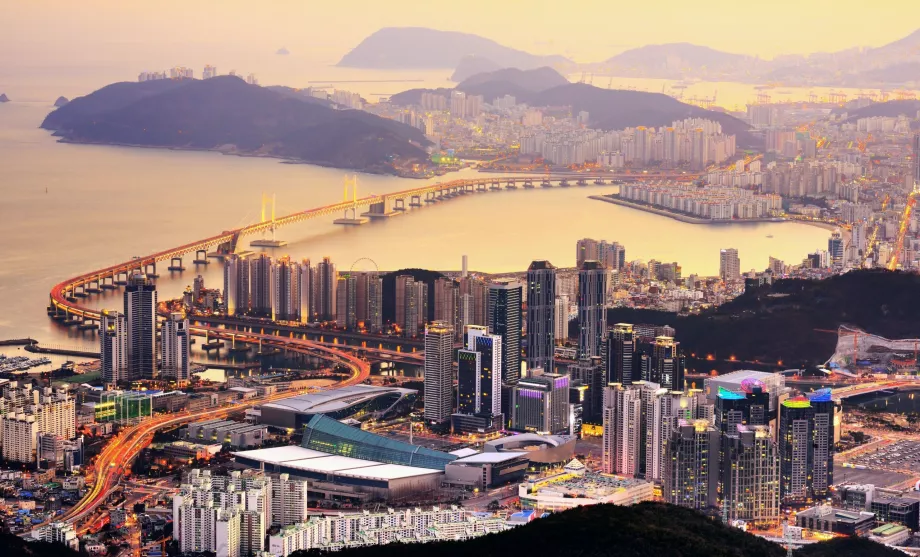Weather in Busan and best time to go

Pusan is located in the very south of the Korean peninsula and enjoys a mild humid subtropical climate.
Extreme temperatures are rather rare, but due to the still strong influence of the continental Siberian climate, Busan also experiences the classic 4 seasons.
The weather in Busan is a little friendlier than the weather in the capital, Seoul. In winter, even in Busan, frost can occur, but much less frequently and temperatures rarely drop below -5°C.
The summers are sultry and very humid, but the maximum temperatures do not climb as high as in Seoul and the overall climate is a little more pleasant.
Temperatures during the year
What is the weather like in Busan during the different months of the year? Read on.
Weather in January
January weather tends to be windy and very cold. Temperatures normally range between 0 °C and 4 °C, but days when the temperature drops below zero are not uncommon. However, snowfall is minimal and rainfall is low. It usually rains no more than one day at a time and no more than 5 days out of the month.
Most of the time the weather is sunny, and there are minimal tourists in Busan in January, so even accommodation prices go down a bit.
Weather in February
February weather has similar characteristics to January weather. Temperatures rise to an average of 5 °C. Although it rains a little more than in January, it is still mostly rainfall lasting no more than one afternoon. The rain is quickly dispersed by fresh winds.
Weather in March
During March, temperatures reach more spring-like values of around 13 °C for the first time, but mornings and nights can still be very cold. A fresh wind often blows, making the temperature feel lower.
It rains relatively often in March, but the length of the rain shortens with spring and showers rarely last more than 2 hours. They are interspersed with beautiful clear and sunny weather.
Weather in April
April is a very pleasant month for hiking along the Pusan coast and local hills. Temperatures stay at a pleasant 18°C, and every 3rd day or so, the rain comes down harder, but it leaves as quickly as it came and is replaced by sunny or partly cloudy skies.
In the first half of April, cherry blossom blossoms peak, attracting tourists from all over the world to Korea.
Weather in May
May tends to be the last pleasant month when humidity is kept at a reasonable level, as well as temperatures rising to a maximum of 22°C.
Mostly sunny skies prevail, interrupted by a few heavy but limited showers every three days. Even May is thus a very good month for urban and hiking.
There is no sea for swimming yet: the water temperature rises to a maximum of 17 °C.
Weather in June
June's weather is spoilt for choice in terms of high humidity, but is still more tolerable than in the rest of South Korea.
Maximum temperatures soar to around 25 °C and the ocean breeze makes the humid climate feel more pleasant. However, it rains significantly more than in spring, with heavy showers about every third day. However, the rest of the season is sunny.
The sea water reaches temperatures of around 20 °C and the beaches gradually fill up.
Weather in July
July is the rainiest month of the year, with strong afternoon thunderstorms on average 14 days a month. However, the morning and early afternoon are mostly sunny.
Temperatures soar to 28 °C and high humidity means that the main activity is lying on the beaches and swimming in the sea, which rises to 24 °C.
Weather in August
August is the hottest month of the year with an average temperature of 29 to 30 °C and also the time of year when typhoons occur from time to time (normally once a year). Strong storms with wind can last for several days at a time.
However, the rest of the month is sunny, with only quick showers.
The sea water temperature is around 27 °C.
Weather in September
During September, there is still a hot, humid period, during which typhoons or severe thunderstorms may occur. Temperatures drop slowly and stay around 26 °C.
Rainfall is significantly less than in July or August, but showers are still very frequent, although usually brief.
September is one of the best months for a beach holiday thanks to sea temperatures of around 25 °C.
Weather in October
The weather changes quickly between September and October. Typhoons and strong thunderstorms go away, humidity drops rapidly, as does the temperature, which drops to an average of 22 °C.
Rain only comes in the form of light showers about 5 days a month and the weather is very constant with mostly clear skies. The trees in the vast forests are slowly turning colour, making October one of the best months to visit Busan.
The sea water is around 22°C in October.
Weather in November
Even the weather in November is very stable with mostly clear skies. Although temperatures are dropping, they are still between 14 and 16°C, which is ideal for strolling through the colourful forests and parks.
The air is dry and clear, made more pleasant by the ocean breeze. November, along with October, is one of the main seasons for urban tourism.
Weather in December
During December, winter sets in quite rapidly and temperatures drop to an average of 7 to 10°C with frequent cold winds from the mainland.
Otherwise, however, the weather is almost exemplary. There are only about 4 days of light rain showers, while the rest of the month the sun shines in the sky.
Table of temperatures during the year
Busan - Air and sea temperatures during the year
When to go to Busan
The peak season for urban hiking and walking in the hills and along the coast is in October and November and also during April. During these periods, the weather is at its coldest, with mostly clear skies and pleasant temperatures between 15 and 22 °C.
The cherry blossom season in Busan peaks in late March and early April.
Spring and autumn are almost flawless in Busan and you can hardly go wrong with a trip during this period.
Compare prices for flights to Busan
If you don't mind temperatures around zero, then winter isn't a bad time at all either. In Busan, snowfall is minimal and the weather is sunny most of the time. The downside, however, is the early darkness that sets in around 5pm.
If you want to go swimming in the sea in Busan, the best time is September, when it's still warm but not raining as much. The least suitable times are August, when typhoons are most likely, and July, when humidity is at its highest.
Any questions left?
If you have any questions or comments about the article...


very interesting!